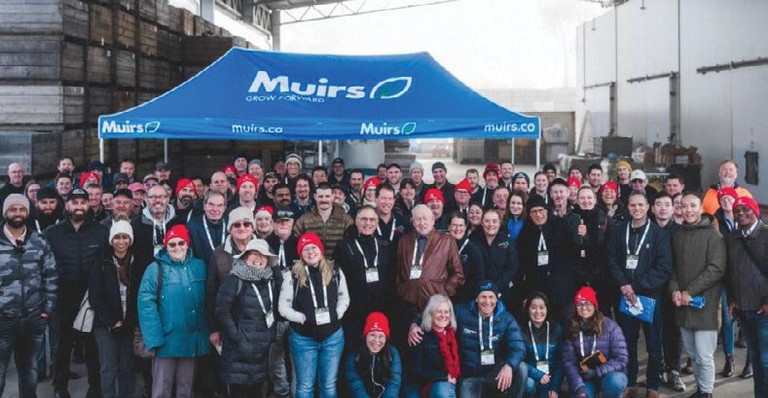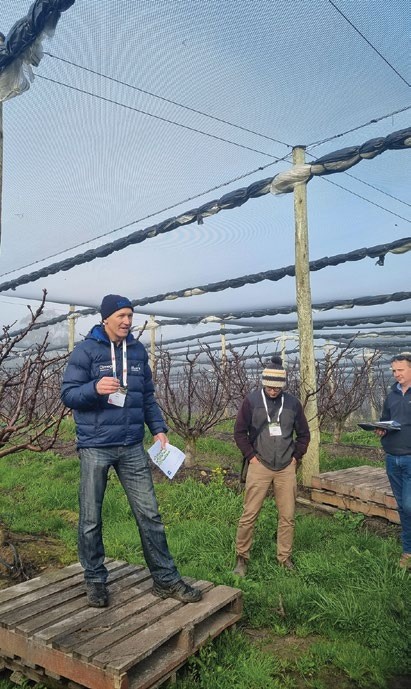WA STONEFRUIT cherry conference
Australian
CHERRY INDUSTRY CONFERENCE
Hobart 2024
The Australian Cherry Industry invited me as the WA Stonefruit representative to the Australian Cherry Conference, which was held in Hobart on the 31st of July to the 2nd of August.
Words Ross Anile, Value Chain Facilitator, WA Stonefruit
THE conference was attended by 250 growers/delegates from the Australian and New Zealand Cherry Industry, where there was a desire by Australian Cherry Growers to unite and develop a strong Australian Cherry Industry.
The conference was also attended by representatives from many support industries to share with delegates new products and innovations, to assist with growing/presentation of quality cherries for the domestic and international markets.
A select few of the guest speakers
The conference was held over 3 days, with the first day focusing on international/national trade figures. There were 22 guest speakers over the first 2 days from many cherry industry and scientific support groups. This report highlights a few of the presenters, all presenters were engaging and informative.
Alison Jones President of Cherry Growers Australia gave an informative positive presentation on the future structure of the organisation.
James Allen from DAFF gave an overview on Fair Trade Agreements and their challenges.
Snapshot of the Australian cherry industry
15,114t
of cherries are grown in Australia per year, valued at $262.2m.
19%
is exported, with 71% sold in the domestic market and 10% used in processing cherry by products.
3%
Western Australia’s market share of the cherry industry. Currently new cherry orchards are being planted in WA with conservative estimated plantings of over 70,000 trees over the next 5 years. These plantings will increase our national market share, depending on the development of other cherry farms in the eastern states.
The international figures are quite interesting:
• Turkey is the largest producer of cherries, where they grow 900,000t and export 250,000t.
• Chile our largest southern hemisphere competitor grows 465,000t and exports 414,000t.
• Chile projected 2026–27 cherry production will lift to 851,000t, with an estimated export figure of 715,000t.
Source: producereport.com.


Orchard visit
Day 3 Visit to Muirs Orchards at Lucaston Park in the Huon Valley. The object of the farm visit was to be briefed on knowing your soil and required nutrients. Visual appreciation and understanding the need for protective covers plus a packhouse tour. The layout, presentation and size of the orchards was quite inspiring. After the farm visit, we were able to view the new Nufarm and Cropland autonomous spraying equipment. It gave us all a vision of the future development of robotics.
These agreements are not clear and concise when considering biosecurity protocols governed by each trading country. International trade is always successful if trade is reciprocal. DAFF is currently assisting exporters with 196 Export permits for Australian produce and 140 import access permits for importers.
India Future Market
Yemee, Fernandes, Executive Director of FPT Pty Ltd, gave an overview on the growing market for Australian produce in India. Yemee is a leading international trade executive, specialising in assisting exporters to enter and trade in India.
India is an evolving market with over 50 million high income earners who desire quality fresh produce. Australia is seen as a provider of some the worlds freshest and safest quality produce. Trading with India in the past has been difficult, but India is developing new protocols and standards to ensure the easier transition for exporters to enter the Indian market.
India has a young population who have a desire to purchase quality fresh produce and have the income to do so. Price is not the main consideration, as health and wellbeing is their main concern.
Retail Doctor Group
Brian Walker presented the delegates with a vision of the future retailing trends. Brian explained we are currently in the 4th Industrial Revolution, Robotics’, AI, Time Poor. Time is currency.
The 5th Industrial Revolution is coming, and it is an accelerated form of the 4th Industrial Revolution. Online purchasing of goods is gathering momentum and well be the norm in 10 to 15 years.
All businesses need to invest into new forms of marketing through media platforms such as Chat Box, Facebook etc, to achieve maximum exposure and be relevant to the consumer.
Farmers will be asked to become more interactive with the consumer and selling the story.
The role of AI will become such an important tool to farmers and businesses, in assisting in:
1. Efficiency gains in labour usage.
2. Better use of natural resources such as water.
3. Soil testing, leading to better use of nutrients and understanding your soil health and requirements to maximise production returns.
Steritech Australia
Brian Reilly represented Steritech, who are the major supplies of irradiation treatments systems in Australia. Currently there are 2 systems in operation to treat produce destined for export. One in Brisbane and the other in Melbourne. There are ongoing discussions with Federal and State governments, investigation the need for irradiation treatment plants to be located in other states.
Many of our trading partners are now accepting irradiated treated produce, and if we are to plan for the future, additional treatment plants are necessary to meet our export objectives.
University of Tasmania: Nardine Hoelzel
Nardine is a hands-on scientist in applied agriculture and nutritional science. Whose research explores the red pigments in cherries, called anthocyanins, and their relationship with our health.
Some of the health benefits of cherries:
• High Antioxidants
• Better cognitive function
• Gut health
• Cardiovascular health.